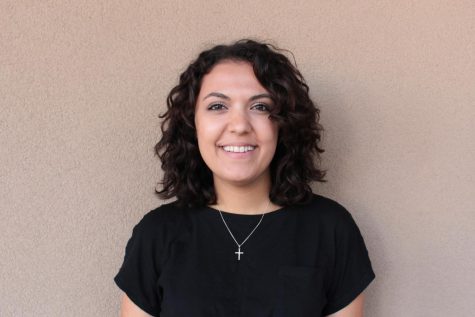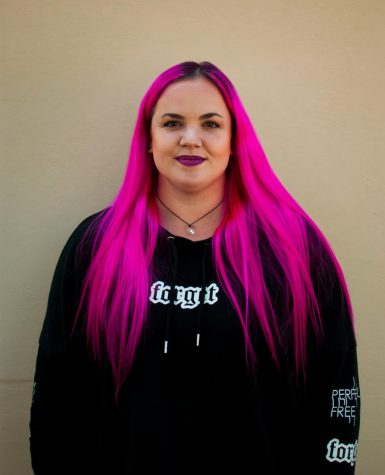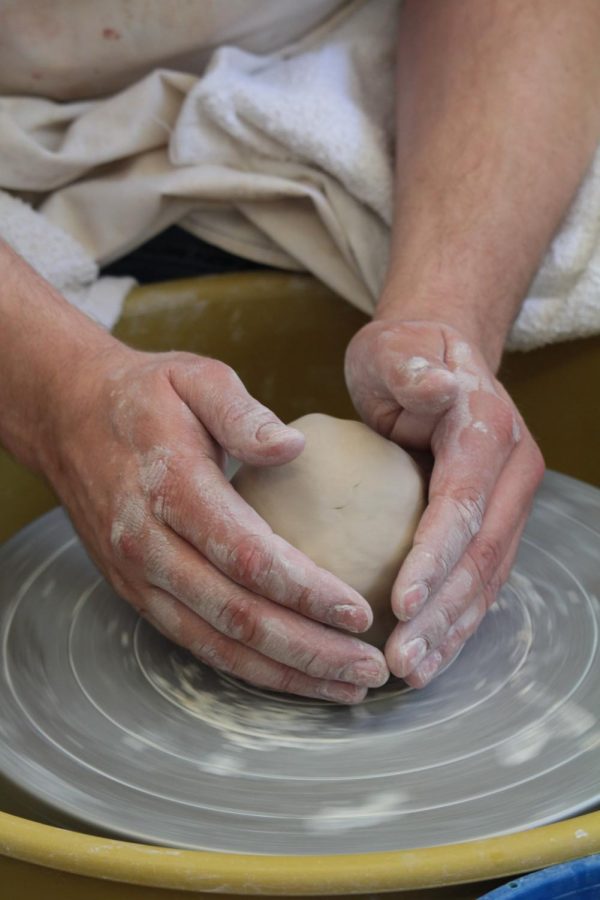Ceramics, Turning Wheels
How one GCC program is truly one of a kind, just like student’s creations
A student demonstrates how to shape clay on a turning wheel.
Dull stairs lead up to a building so overlooked, that if it was gone tomorrow, most students wouldn’t notice it’s missing. Most. It’s a less populated part of campus, but has become home to the community of creatives and fine art connoisseurs.
Upon walking into the ceramics lab in the Aviation Arts building, one steps into a whole new realm of college life. Suddenly, the precalculus anxiety and science stress are no more. Everything becomes timeless and calm, and the only thing indicating a sense of time are the texture or moisture of one’s ceramic piece.
To the left of the studio is the ‘kiln,’ a furnace oven designed for baking or as they say in the ceramics world, ‘firing’ pottery. Across from the kiln are all the different types of glaze and paint that students use to color their pieces.
Although it seems that ‘glazing’ or coloring pottery is as easy as watercolor on paper, it takes a professional to understand the distinct differences. Many factors go into the final color of the piece one makes. Temperature, composition, colorants and other glaze materials are just a few of the things that affect the final product. For example, if the colorants are volatile, they will dissipate into the kiln atmosphere if it is fired at a high temperature. Essentially, the deceiving nature of glazing is exactly what makes it so much more fascinating for students.
Straight ahead, through the studio room, one sees the work space; tall tables paired with stools, there’s a wrap around path of the turning wheel, where students gather to make their pottery. All in all, it’s a warm and welcoming environment, where students feel inspired to create.
“The clay room feels like home to me, I feel like I’m in a different world,” ceramics major Caye Hartman said. “I’m free from my busy life and I’m able to create things, and being around creative minds makes me happy.”
The leaders of the department have done everything possible to create a stress-free environment to influence prolific freedom for their students.
“Some [students] come here with a little bit of experience,” Ceramics Department chair Richard McColl said. “Knowing the basics, they come here to learn the form, and we have structured a program that you can take to any university and you are at the top of your class. We give people foundation.”
Many years ago, when the previous head of the Ceramics Department, Robert Kibler started the program, he had no idea that it would become such a big success. The small program grew popular within the student body and is now one of the most sought after in the area. It offers over ten classes to choose from, covering everything from history of ceramics, technique, form, glazing, design and calculation. Glendale Community College also offers a prominent certificate program to be completed in two years or four semesters.
“[You] get an experience not only in technique but in form and in glazing and design and history of ceramics, there’s a rhythm element to everything,” McColl added. “It’s not just college, you learn a lot that can transfer to the rest of your life and the rest of your college career, which is fantastic.”
When asked about the competitiveness of the field, finding real life jobs and the outcomes of having a ceramics degree, McColl explained that one can make it in any field if they have passion, willpower and dedication for their craft.
“It’s definitely hard to find a job, but you can create a job,” he explained. “We have students who are running businesses, students who are teaching, students who have transferred. We have students who are running most of the ceramics centers in the area.”
He then proceeded to parade some of his students who recently had shows in New York and Tokyo.
“We have really talented people getting out of here,” McColl smiled proudly.
As students get more comfortable with the clay and find their inspirations, they become part of a bigger learning experience; marketing and learning. The Ceramics Department holds annual winter sales of the artwork of its students. By doing this, they allow students to get more of a real-life, hands-on experience of what it will be like to make a living as a ceramics artist.
“[They] learn how to market [their] work, exhibit [their] work. We teach how to make pieces that can be exhibited in competitive jury exhibitions around the world,” said McColl.
Depending on the level of technique and advancement used, pieces normally range from a few dollars to a few hundred dollars. Eighty percent of the proceeds of the sale goes to the student artist, and the other 20 is donated to the department for maintenance, for things such as clay, colors and replacing the kiln.
Seemingly a universe of its own, ceramics is just one of many little worlds residing under the name of GCC. As we journey through each program on campus, one can’t help but think, what’s next?
Marian Sahakyan can be reached at [email protected].

Growing up in a big family of journalists and writers, Marian developed her love for writing and reporting since early childhood. She is often found in...

Belinda Oldrati is an international student from Sweden, and one of the Production Editors of El Vaquero newspaper. She studies Journalism, TV Production,...

